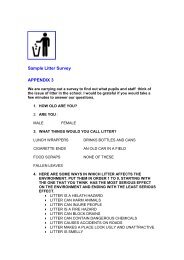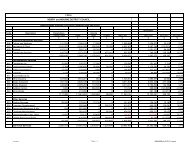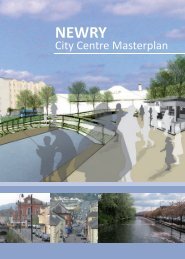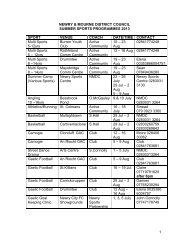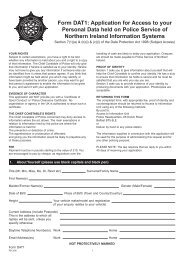Newry and Mourne District Council
Newry and Mourne District Council
Newry and Mourne District Council
You also want an ePaper? Increase the reach of your titles
YUMPU automatically turns print PDFs into web optimized ePapers that Google loves.
<strong>Newry</strong> City Centre Strategic Development Framework March 2004<br />
ii.<br />
iii.<br />
iv.<br />
the bulky durable comparison shopping has decreased quite dramatically <strong>and</strong> has been<br />
replaced with retail service uses. The non-bulky comparison shopping is still quite strong, but<br />
the type is of a lower order than normally found in a main shopping street. There are also<br />
three community service uses where there were previously none. In the past Monaghan<br />
Street would have been a primary retail street but it has evolved into one that now provides<br />
more of a district centre function serving the local community in the north west of the city<br />
centre. It is considered that as the city grows, this will be an important function for the<br />
street. As this part of the urban area takes on more of a role of being a district centre, so the<br />
importance of Monaghan Street as a district shopping centre will be reinforced. The main<br />
policies for the area therefore should be to carry out an environmental improvement scheme<br />
on the street, encourage shop frontage to move back onto the street edge. This is especially<br />
the case at the Dunnes site <strong>and</strong> encourage restaurants, bars <strong>and</strong> small comparison <strong>and</strong><br />
convenience shops to develop.<br />
Railway Avenue – this street is in close proximity to Monaghan Street. It has changed from<br />
being a mix of retail service <strong>and</strong> comparison shopping in 1999 to almost entirely retail service<br />
(mostly hairdressers) in 2003. The nature of the uses means this street does not make a<br />
major contribution to the vitality <strong>and</strong> viability of the city centre. However, it has a recognised<br />
niche market for this part of the city centre <strong>and</strong> the car park is a possible opportunity site.<br />
Lower Catherine Street – this street comprises mostly community <strong>and</strong> retail services <strong>and</strong><br />
whilst not making a significant contribution to the vitality of the city centre, has improved<br />
since 1999 with no vacancies <strong>and</strong> an improved image possibly assisted by the removal of the<br />
police station providing a more open <strong>and</strong> pleasant environment. The former police station<br />
site, <strong>and</strong> McClell<strong>and</strong> Square provide a major redevelopment opportunity site in this part of<br />
the city centre. This area should be retained within the city centre boundary, promoted for<br />
city centre uses <strong>and</strong> better enhanced by the provision of links with Monaghan Street.<br />
Edward Street/ Upper Edward Street <strong>and</strong> Corry’s Square - the only retail uses on<br />
these streets, are a few bulky durable comparison shops. Aside from these, the area consists<br />
mostly of open storage such as the bus depot, vacant properties, car garages <strong>and</strong> some<br />
residential. None of these contribute significantly to the vitality <strong>and</strong> viability of the city<br />
centre. Consideration should be given to the promotion of the area for high-density<br />
residential development, particularly in some of the existing derelict warehouse buildings.<br />
v. Canal Street/ Sugar Isl<strong>and</strong>/ Sugarhouse Quay/ Canal Quay/ Basin Walk/ New<br />
Street – these streets have been grouped together because they provide the same function<br />
within the city centre. The area could be regarded as a district or quarter in the north of the<br />
centre. They have changed little since 1999 apart from some increased vacancies. However,<br />
there has also been an increase in the number of community service uses such as solicitors.<br />
This is an area in transition. It is also potentially one of the most attractive parts of the city<br />
centre with its historic street pattern <strong>and</strong> a number of fine warehouse buildings. It will<br />
require significant public expenditure to ensure that its potential is not lost. It is an important<br />
gateway into the city <strong>and</strong> could be the focus for entertainment <strong>and</strong> office uses.<br />
vi. Hill Street/ John Mitchell Place – these streets have seen a fairly significant increase in<br />
the number of units, mainly from sub division of properties <strong>and</strong> the use of upper floors for<br />
community service type uses. It remains the focus for comparison shopping <strong>and</strong> is still the<br />
most vibrant part of the city centre. However, there has been a slight decrease in the<br />
number of bulky durable shops such as furniture shops, which are now more likely to be<br />
located on an edge of centre or out of centre site. There is also a sizeable increase in the<br />
number of retail service uses on Hill Street <strong>and</strong> John Mitchell Place. These are mainly financial<br />
institutions, which leads to a nine to five economy <strong>and</strong> a street, which is less vibrant in the<br />
evening. The nature of the streetscape <strong>and</strong> the existence of the Squares would lend itself to a<br />
pedestrianised street. Previous attempts at pedestrianising Hill Street have failed due to lack<br />
of provision of alternative parking <strong>and</strong> servicing. The retail service uses should be encouraged<br />
to relocate to less prominent positions in the street <strong>and</strong> replaced with bars, restaurants <strong>and</strong><br />
cafes that “spill” out onto the street at the two squares. The taxis also need to be removed<br />
from the Squares <strong>and</strong> relocated in a proper taxi rank close to the city centre<br />
vii. Mall - in 1999 the commercial properties that were on the Mall were mostly vacant. In 2003,<br />
while the same number of vacancies still occur, there are an increased number of restaurants<br />
<strong>and</strong> a few comparison <strong>and</strong> convenience good shops, most of which are clustered round the<br />
junctions with Margaret, Marcus <strong>and</strong> O’Hagan Streets. The Mall has the potential to become<br />
a city centre residential <strong>and</strong> restaurant street <strong>and</strong> the appearance <strong>and</strong> scale of the buildings<br />
will be important in creating the right image. Buildings should be at least 4 to 5 storeys in<br />
height <strong>and</strong> any visual barriers inhibiting views of the river <strong>and</strong> canal <strong>and</strong> across to Merchants<br />
Quay should be removed. Traffic use should be restricted to make it a pedestrian friendly<br />
place. The bus depot building is on a prime site but the nature of the use results in the area<br />
being dominated by vehicles. Consideration should be given to the relocation of the bus<br />
Ferguson McIlveen in association with Mentor <strong>and</strong> Scott Wilson Page No. 5




